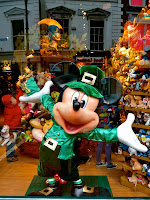 |
| Dublin Hosts-Marcin and Joe |
 |
| The protesters begin to gather. |
Dublin with day trips out of the city. They realized, and at times were lectured by Dubliners, that the west coast was more typical of true Ireland, but visiting the coast would have to wait until their next trip overseas.
 |
| Disney Store Dublin |
 |
| The Liffy River |
government's newly installed property taxes at the palace where a committee from the E.U. were meeting to discuss finances. This was just one of the many protests, although arguably the largest, they observed over the last few months.
 |
| Trinity College Library |
The city tour was able to proceed although the route needed to be adjusted because of the march. The focus of their tour was on the rebellion and the subsequent referendum for the Republic of Ireland's independence from the U.K. In the referendum of 1916 all districts in Ireland voted to stay with the UK or become independent. Only four the northern districts voted not to leave and these four, of course, became
Northern Ireland. Although Ireland experienced some violence since their separation, it was nominal compared to that of Northern Ireland.
After the educational aspect of their day was completed, Rob and Beth retired to ‘The Temple Bar district’ of town and spent the late afternoon sitting in one of the many pubs in this area that hosted local musicians. They enjoyed Irish fare, a hearty stew for Rob and soup and chips for
Beth, a pint of Guinness and Bulmer's cider and listened to the music. Although most of the music was traditional Irish fare - Dirty Old Town, Whisky in the Jar, My Paddy Worked on the Railway, The Belle of Bellfast - oddly enough, all three of the musical groups also seemed to have the same play list for the "non Irish" songs that included Johnny Cash, John Denver, & Green Day.
* * * *
 |
| Hiking the less treacherous coastal side. |
On a sunny yet breezy day, they hopped on a train and headed to the nearby town of Howth. This little fishing port town was a quaint, sleepy town compared to the hustle of Dublin which is why Dubliners flock to this town in the summertime as an escape.
At one of the seafood restaurants that lined its pier they enjoyed fresh calamari, shrimp and mussels while they soaked up the sun's warm rays which lately had been so evasive. They understood that the winter had been as long in the UK as it had been in Canada. Everyone was happy to see the sun even though the brisk northern wind continued to blow.
After lunch they headed off for the true purpose of their visit - the cliffside hike. This nine km trail led

 through diverse landscape. At times they had to carefully negotiate their way along a trail that led along the edge of a cliff battling a 20 knot wind that threatened to blow them off into the Irish sea 150 metres down. At other times they walked through a meadow filled with bright yellow-flowered scrub or along a stonewall mortared with seashells that partitioned farmland.
through diverse landscape. At times they had to carefully negotiate their way along a trail that led along the edge of a cliff battling a 20 knot wind that threatened to blow them off into the Irish sea 150 metres down. At other times they walked through a meadow filled with bright yellow-flowered scrub or along a stonewall mortared with seashells that partitioned farmland.
The circular trail ended in Howth and they enjoyed a bowl of hearty tomato soup in the only pub that was open before heading home for the day.














































